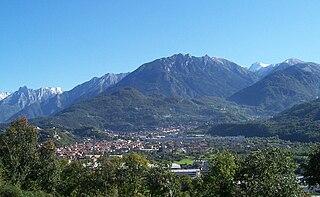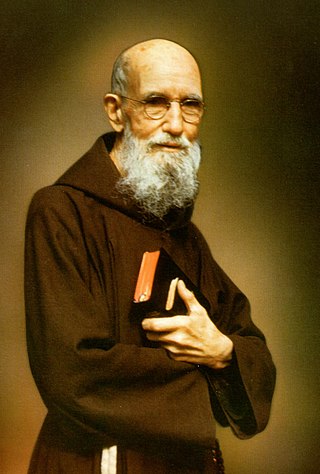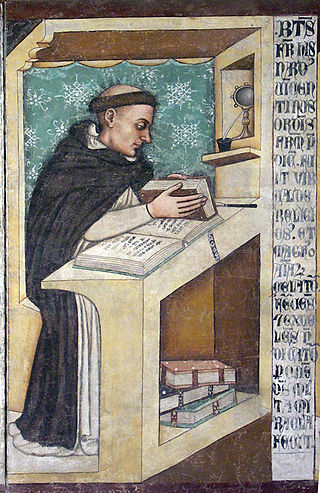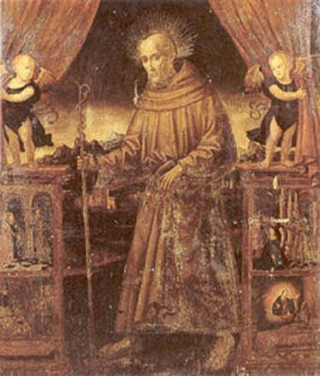
The Order of Friars Minor Capuchin is a religious order of Franciscan friars within the Catholic Church, one of three "First Orders" that reformed from the Franciscan Friars Minor Observant, the other being the Conventuals (OFMConv). Franciscans reformed as Capuchins in 1525 with the purpose of regaining the original Habit (tunic) of St. Francis of Assisi and also for returning to a stricter observance of the rule established by Francis of Assisi in 1209.

Berzo Inferiore is an Italian comune of 2,316 inhabitants in Val Camonica, province of Brescia, in Lombardy, northern Italy.
Giovanni Battista Righi was an Italian Roman Catholic priest and a professed member from the Order of Friars Minor. He was known for ascetic life and for his preaching and healing abilities.

Solanus Casey, OFM Cap, born Bernard Francis Casey, was an American religious priest of the Order of Friars Minor Capuchin. He was known during his lifetime as a healer for his great faith and his abilities as a spiritual counselor, but especially for his great attention to the sick, for whom he celebrated special Masses. The friar was much sought-after and revered, especially in Detroit, where he resided. He was also a noted lover of the violin, a trait he shared with his eponym, Saint Francis Solanus.
Jeremiah of Wallachia was a Romanian-born Capuchin lay brother who spent his entire adult life serving as an infirmarian of the Order in Italy. He was beatified by Pope John Paul II on 30 October 1983, the first of his nation to be so honored. Born Ion Costist or Ioan (John) Costişte, he emigrated to Naples during his adolescence. Also known as Geremia from Wallachia, he became noted for his careful attention to the merciful works and to the care of the poor. His vision of the Blessed Mother resulted in one of the best known images created of him.

Bernard of Offida - born Domenico Peroni - was an Italian Roman Catholic professed religious from the Order of Friars Minor Capuchin from the Marche area. Peroni lived for the most part in servitude to his fellow friars in various capacities and he was noted for his strong Eucharistic dedication and for his holiness.
Francesco Maria da Camporosso - born Giovanni Croese - was an Italian Roman Catholic professed religious from the Order of Friars Minor Capuchin. Croese became a beggar in Genoa where he sought alms from people and was at first heckled and assaulted before his reputation for personal holiness spread which prompted people to come and see him.

Claudio Granzotto was an Italian professed religious from the Order of Friars Minor and a noted sculptor. Granzotto's works were a conduit for his religious expression and are reflective of his dedication to use sculpting to evangelize to others.

Tommaso da Olera - born Tommaso Acerbis was a Roman Catholic Italian friar of the Capuchins. Leading a life of humility and service, Acerbis, initially a shepherd with no formal education, joined the Order of Friars Minor Capuchin in Verona at the age of seventeen. He served in various convents, offering spiritual guidance to the sick and impoverished. Acerbis spoke out against the spread of Lutheranism, defending the Roman Catholic Church through his love for "the impassioned Christ". His influence extended to sponsoring convents and spiritually guiding notable individuals, including Bernardina Floriani and scientist Ippolito Guarinoni. Acerbis's devotion earned him papal veneration, with Pope John XXIII recognizing him as "a saint and a true master of the spirit". The beatification process, initiated in 1967, culminated in his proclamation as Venerable on 23 October 1987. A miracle further validated his cause, leading to beatification on 21 September 2013, presided over by Cardinal Angelo Amato on behalf of Pope Francis.

Leopoldo da Gaiche, born Giovanni Croci, was an Italian Roman Catholic priest and a professed member of the Order of Friars Minor who became well known for wearing a crown of thorns. He was a preacher who went from diocese to diocese and served in a position of power in the Franciscan order in the Umbrian region in which he pushed for strong adherence to the Rule of Saint Francis of Assisi. He has been called the "Apostle of Umbria".

Ugolino da Gualdo Cattaneo was an Italian Roman Catholic professed religious and friar of the Order of Saint Augustine. Ugolino is best known for founding an Augustinian convent in Gualdo Cattaneo in 1258 where he served as its prior until his death. He practiced a rigorous spiritual life with austerities including frequent bouts of strict silence and fasting.

Luca Antonio Falcone – in religious life Angelo – was an Italian Roman Catholic priest and a professed member of the Franciscan Order of Friars Minor Capuchin in Cosenza. Falcone had a rough call to religious life after several entries and exits into the order and he later served as a noted preacher across southern Italian cities such as Catanzaro and Salerno after his first few sermons attracted little following. He became titled as both the "Angel of Peace" and the "Apostle of the South".

Guala de Roniis was an Italian catholic priest and a professed member of the Order of Preachers as one of Dominic of Osma's earliest disciples. De Roniis was born as a noble and was appointed as the Bishop of Brescia after Dominic's death though also served as a popular papal legate that earned him popular and papal support. He resigned from his episcopal see to dedicate the remainder of his life to peaceful solitude though his reputation for personal holiness prompted countless people to seek him out for his counsel.
Antonio da Stroncone was an Italian friar of the Order of Friars Minor. He became a member of that order in his youth after cultivating a strong devotion to Francis of Assisi during his childhood with his parents who were members of the Third Order of Saint Francis.

Arsenio da Trigolo, OFM Cap., was an Italian Catholic priest and a professed member from the Order of Friars Minor Capuchin.
Francesco Saverio Toppi - born Vincenzo Toppi - was an Italian Capuchin who served as the Prelate of Pompei from 1990 until his resignation in 2001. Toppi fostered a deep devotion to the Blessed Mother and this devotion further developed and was solidified when he was appointed to oversee the Marian shrine in the Pompei prelature. He carried out his duties to the fullest as a teacher serving in Palermo and Naples prior to his episcopal appointment and served in various capacities of leadership for his order.

Antonio Pietro Cortinovis - in religious Cecilio Maria da Costa Serina - was a Lombard Roman Catholic professed religious from the Order of Friars Minor Capuchin. He had set his heart on entering the religious life despite his initial reluctance due to him pondering on his unworthiness. This belief manifested in his childhood which motivated him to decide against entering the priesthood. But his religious formation in the order was pushed back due to World War I and he was unable to make his solemn religious profession until the war had concluded.

Gabriel Ferretti was an Italian Roman Catholic priest and a professed member of the Order of Friars Minor. He was an ancestor to both Cardinal Gabriele Ferretti and Pope Pius IX having been descended from a long noble lineage. Ferretti entered the religious life after becoming of age and soon after his ordination held two important leadership positions in the order. He set about restoring run down Franciscan convents in the region as well as seeing to the establishment of new ones to deal with an influx of new novices.

Isnardo da Chiampo, OP was an Italian Catholic priest and professed member in the Order of Preachers.

Gerardo Cagnoli was an Italian Roman Catholic and professed religious from the Order of Friars Minor. He embarked on a long pilgrimage south where he passed through Rome and Naples before settling in Trapani and then on the slopes of Mount Etna for a long hermitage. He later entered the Franciscans and served in two of their Sicilian convents where he was known for having caused miracles in addition to his humble and simple childlike nature which people believed was one of the signs of his holiness.















